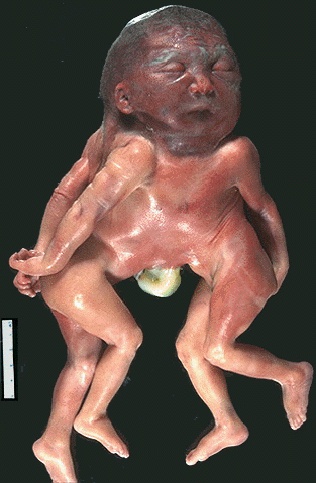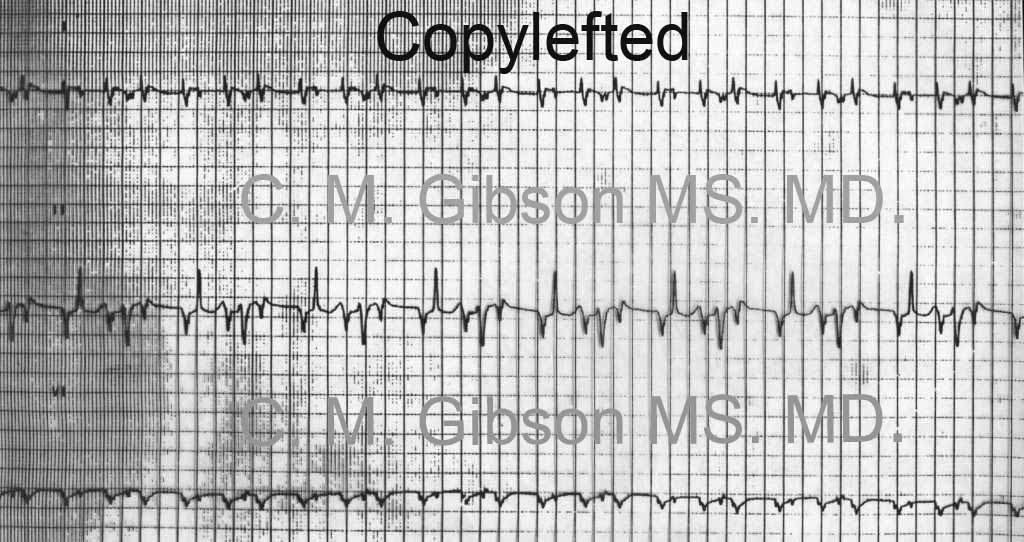The heart in conjoined twins
 From Wikidoc - Reading time: 5 min
From Wikidoc - Reading time: 5 min
| The heart in conjoined twins | |
 | |
|---|---|
| Conjoined twins. Craniothoracopagus. Image courtesy of Ed Friedlander, M.D., Pathologist |
Editor-In-Chief: C. Michael Gibson, M.S., M.D. [1]
Overview[edit | edit source]
Evaluation of the cardiovascular system (for planned operations or any follow up purpose) is essential in all conjoined twins, whether or not the hearts are conjoined as determined from prenatal studies.
Echocardiography and electrocardiography are performed to determine the presence of anomalies in the case of separate hearts and to determine the sites where the hearts are joined and the presence of abnormalities in the case of conjoined hearts.
Cardiac (heart) catheterization was previously the essential for further diagnosis of complex congenital and acquired heart anomalies, but nowadays this invasive method replaced by the three-dimensional cardiac magnetic resonance angiography.
Cardiac magnetic resonance angiography provides precise anatomic information that may help to decide whether or not heart separation should be attempted.
The presence of a single heart beat on EKG usually indicates that successful cardiac separation would not be possible, but the presence of two separate beating systems does not necessarily indicate a better outcome. [1]
Types of conjoined twins[edit | edit source]
There are several different types of conjoined twins:
- Diplopagus: Conjoined twins joined equally with near complete body, only sharing a few organs.
- Heteropagus: Conjoined twins joined unequal usually resulting in a parasitic twin.
- Thoracopagus: Bodies fused in the thorax. The heart is always involved in these cases; when the heart is shared, prospects for a long life, either with or without separation surgery, are poor (35-40% of cases).
- Omphalopagus: Joined at the lower chest. The heart is not involved in these cases but the twins often share a liver, digestive system, diaphragm and other organs (34% of cases).
- Xiphopagous: bodies fused in the xiphoid cartilage
- Pygopagus (iliopagus): Joined, usually back to back, to the buttocks (19% of conjoined twins).
- Cephalopagus: Heads fused, bodies separated. These twins generally cannot survive due to severe malformations of the brain. Also known as janiceps (after the two-faced god Janus) or syncephalus.
- Cephalothoracopagus: Bodies fused in the head and thorax. In this type of twins, there are two faces facing in opposite directions, or sometimes a single face and an enlarged skull.[2] These twins also generally cannot survive. (Also known as epholothoracopagus or craniothoracopagus.)
- Craniopagus: Skulls fused, but bodies separate (2%).
- Craniopagus parasiticus: A second bodiless head attached to the head.
- Dicephalus: Two heads, one body with two legs and two, three, or four arms (dibrachius, tribrachius or tetrabrachius, respectively.)
- Ischiopagus: Anterior union of the lower half of the body, with spines conjoined at a 180° angle (6% of cases). Or with the spines separate but both the pelvises forming a single big ring which includes two sacrums and two pubic symphyses.
- Ischio-omphalopagus: The most well known type of conjoined twins. The Twins are conjoined with spines in a Y-shape. They have four arms and usually two or three legs. These cases can be challenging because the twins often share reproductive and excretory systems.
- Parapagus: lateral union of the lower half extending variable distances upward, with the heart sometimes involved (5% of cases).
- Diprosopus: One head, with two faces side by side. In some cases, parts of the brain have been known to be shared between conjoined twins joined at the head.
Occasionally one of the twins will fail to develop properly, effectively acting as a parasite upon the normally developed twin: this condition is known as parasitic twinning or heteropagus twins. One twin may absorb the other, which is known as inclusion twinning.
Natural death of the twins can occur within hours or a few days.
EKG Example of Conjoined Twins[edit | edit source]
This EKG example is courtesy of C. Michael Gibson, MS. MD. and copylefted

References[edit | edit source]
- ↑ O'Neill: Principles of Pediatric Surgery. 2003
External Sources[edit | edit source]
- The Use of Radionuclides in the Investigation of Conjoined Twins
- Anaesthetic managements for conjoined twins with complex cardiac anomalies
- Conjoined Twins CME
See also[edit | edit source]
- National Geographic Channel Documentary about Conjoined Twins
- American Pediatric Surgical Association
 KSF
KSF